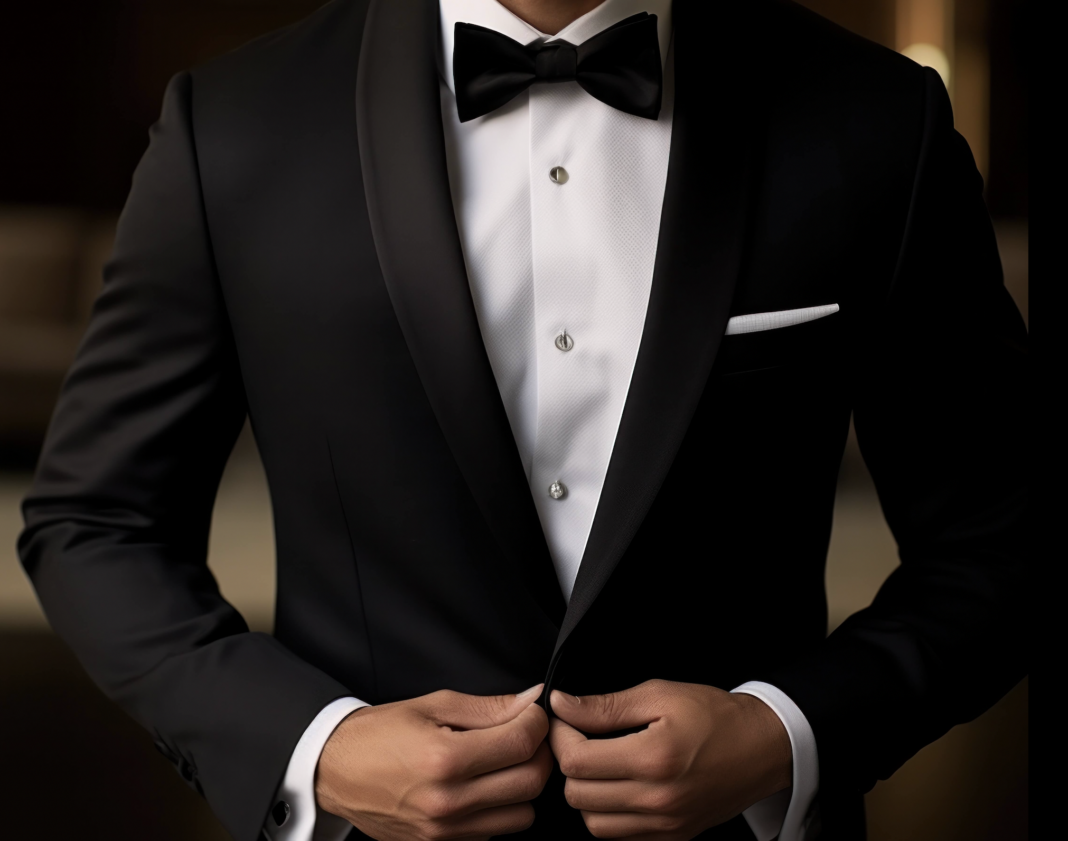The invitation reads “Black Tie,” and suddenly, there’s a certain level of elegance and formality expected from your attire. Whether you’re attending a gala, a wedding, or a prestigious event, understanding the black tie dress code is important to make a lasting impression. Here’s a quick guide to mastering black tie etiquette, as well as unraveling the mystery behind “Black Tie Optional.”
PRO Tip: A black tie dress code is meant to be worn post-6pm.
When it comes to black tie attire, if you wear a tuxedo, you have a fairly straightforward set of guidelines to follow. The quintessential black tie ensemble consists of:
- Tuxedo: Opt for a traditional black tuxedo with satin or grosgrain lapels. A well-fitted suit is key to confidence and sophistication.
- Shirt: A crisp, white dress shirt is a must. Ensure it has a stiff collar that can accommodate a bow tie. While a shirt that has buttons is perfectly fine, if you want to elevate your tuxedo, opt for a shirt that has shirt studs instead.
- Bow Tie: Embrace the classic elegance of a black silk bow tie. Avoid novelty patterns or colors that deviate from the formal aesthetic. Less traditional but still acceptable, is also a black tie.
- Pocket Square: Stick with a classic white if you are going after the most traditional look.
- Footwear: Black patent leather or highly polished leather shoes are classic. Pair them with black dress socks (which are thinner than normal socks) to maintain a seamless look. Interestingly, velvet black slippers are also worn with black tie and are perfectly appropriate to do so.
- Accessories: Complete your ensemble with subtle accessories, such as cufflinks or a sleek watch (avoid athletic watches) which can add a touch of refinement without overpowering the outfit. Are cumberbunds still in? It’s a matter of personal preference and they are still considered traditional. More modern looks include no cumberbund, or a black vest.
Now, if you are wearing a dress to your next black tie affair, there is a bit more flexibility when it comes to color, even though it’s called “black tie”. Here’s what to keep in mind:
- Evening Gown: Opt for a floor-length evening gown in a luxurious fabric such as silk, satin, or chiffon. Dark hues like black, navy, or deep jewel tones are particularly fitting for formal evening events, especially in the winter.
- Neckline: While there’s flexibility in neckline styles, consider elegant options like strapless, halter, or V-neck designs.
What is most important to note is that a gown that is to the knee, or mid-calf (called tea-length) is not considered black tie. Make sure to choose floor length to abide by the correct dress code.
- Accessories: Elevate your ensemble with tasteful accessories. A statement necklace or sparkling earrings can add a touch of glamour. Carry a small clutch or evening bag in a coordinating shade to hold essentials. Remember the more formal the evening, the smaller the bag you should bring.
PRO TIP: With jewelry, remember that the bigger, more sparkly pieces of jewelry traditionally only come out post 6pm. Pre-6pm, it’s recommended to stick with metallic jewelry and gemstones. This tip and much more taught in the full dressing section of Modern Etiquette Made Easy.
- Footwear: Opt for elegant heels in a neutral or metallic shade that complements your gown. Ensure they’re comfortable enough to navigate the event venue with ease. Be sure you are not tripping over your gown and that your shoes are the correct height and size to ensure you can manage walking gracefully with your gown and not have to hold it up the entire evening.
Decoding “Black Tie Optional” Etiquette:
“Black Tie Optional” grants guests the flexibility to choose between traditional black tie attire and slightly less formal alternatives. That being said, if a host includes this on an invitation, they likely are being polite by giving you an alternative, although they still wish for guests to wear black tie if possible. If you do see this on an invitation, here’s what it means:
- While a traditional tuxedo is preferred, a dark suit paired with a white dress shirt and conservative tie is acceptable. Opt for polished dress shoes to complete the ensemble.
- Though an evening gown remains the ideal choice, “Black Tie Optional” permits more flexibility in attire selection. A chic cocktail dress or a sophisticated pantsuit can be appropriate alternatives, paired with elegant accessories and footwear.
Remember, adhering to the dress code demonstrates respect for the event and its hosts. By mastering the art of black tie attire, you’ll exude confidence and sophistication, ensuring you leave a lasting impression wherever you go.


